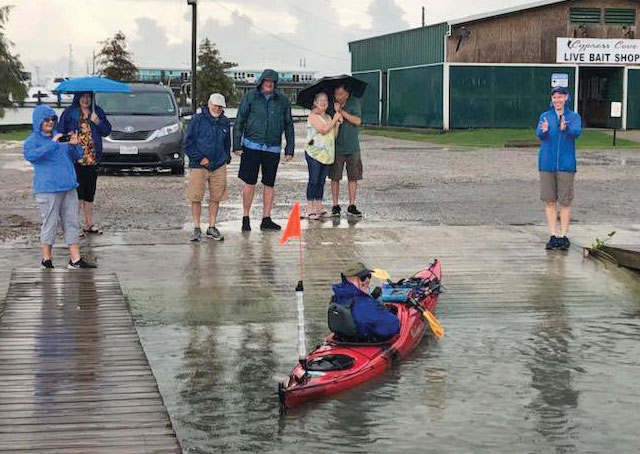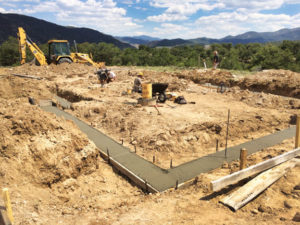By Hannes Zacharias
Dear Colorado Central reader, I made it. I completed my 2,000-mile kayak journey to rediscover the Arkansas and Mississippi rivers; a repeat (in part) of the trip I did 42 years ago. It was a challenging, energizing and rewarding adventure.
When last we visited, I was departing Webber Falls, Oklahoma, heading for the Kerr Reservoir, a long and strenuous paddle across one of the largest reservoirs I’ve encountered. At the end, I connected with two friends from Kansas and Colorado who assisted me getting to Fort Smith, where I joined other friends with an 18-foot bass boat and a 70 horsepower motor that towed me across much of Arkansas and through many of the 18 locks and dams on the McCLellan/Kerr Navigation System. This was a true blessing and a similar experience to one I had in 1976, when I served as a volunteer deckhand on the towboat “Bill Kadd,” roping barges through the entire length of the navigation system.

Being on the crowded and overloaded bass boat posed different challenges; dodging the wakes of barges, now more prevalent than before, avoiding lightning-laden thunderstorms, and managing fuel through the 300 miles of flat water with virtually no marinas. This part of the journey slices through Arkansas where the terrain changes measurably from flat and heavily wooded areas in the west, to high bluffs and unexpected rises in elevation in mid-state, to farm fields and wide expansive reservoirs with alligators and other unfamiliar wildlife. In one case, my friends and I were sealed in one of the locks in the lower part of the Arkansas River with what we thought was a large log, only to find out it was a ten-foot alligator. It is one thing to be in the wild with such a creature where both parties can find a way to escape, but quite another to be confined in a concrete and steel bathtub with the water draining out.
At the mouth of the canal connecting the Mississippi with the Arkansas River, I departed my friends and went solo for the remainder of the 600 miles. I was impressed by the beauty of the river, given its massive volume and width. The river was significantly lower than in 1976, exposing many more sandbars providing ample opportunities to camp where I could enjoy the river from the sloping bars, versus on top or behind the extensive levy systems. The river had no rapids, strainers or uncharted dams, but was not without its dangers, including massive whirlpools, swift and powerful current, and daunting waves caused by passing barges which at times numbered 49 – roughly the size of two football fields, moving up and down the river every 20 minutes. At one point, I did my “seaman’s duty,” assisting a ten-passenger pontoon boat in distress – trapped in the Mississippi current and shipping channel without a working motor. I towed it to safety to a nearby sandbar, a feat I was able to accomplish only following two months of paddling.
[InContentAdTwo]
It was fascinating to approach well-known river towns from my kayak – Greenville, Vicksburg, Natchez – key markers in US history. Outside of Natchez I faced my most serious danger; dehydration and heat exhaustion. After paddling day after day in 95° temperatures and 100 percent humidity, my health was beginning to deteriorate. One morning I became very irritable and recognized that this was not my normal behavior. I realized I had cool and clammy skin, accelerated heart rate, nausea and headaches; all the classic symptoms of these two serious health conditions. Fortunately, maturity convinced me to pull off the river, recover and find alternate means to complete my adventure. As a result, I decided to confine my kayak to a U-Haul, driving it along the river exploring cities and historical sites, and camping in state parks and other areas close to the river. This allowed me to learn a great deal about the Mississippi River, this part of the south, and the wonderful people who occupy the environs therein.
In New Orleans I decided to complete the rest of the journey by boat. I put the kayak back in the water directly across from the French quarter, dodging the constant boat traffic and large oil tankers, and headed downstream. The last day saw me paddling through large thunderstorms, high winds, and avoiding the reported bull sharks, finally pulling off at Venice in to the welcoming arms of my family and friends.
What did I learn from this adventure? I learned that it is important to fulfill the promises we make to ourselves. I learned that people of my generation can still complete adventures, if we do so according to our physical capabilities. I learned that life past retirement (for me) is not a time to be sedentary, but rather to be fully engaged in life with optimism and enthusiasm, making the most of the remaining time I have on this planet. Finally, I learned about the politics, beauty and challenges facing the Arkansas River. I know firsthand the journey a drop of water takes from the Colorado Continental divide to its home in the Gulf of Mexico. A journey that inspires, disappoints and is constantly evolving.
I’m so fortunate to have had this chance to complete this 40-year-old dream. I’m so pleased to have met so many great people and experienced the support of friends and family, without whom it would have been impossible to complete this adventure. I look forward to explaining my journey to those who are willing to listen, and advocate for the 45th longest river in the world and the sixth longest river in the United States. The river deserves strong advocates. As for my future – I am moving on from here to wherever the river takes me.


